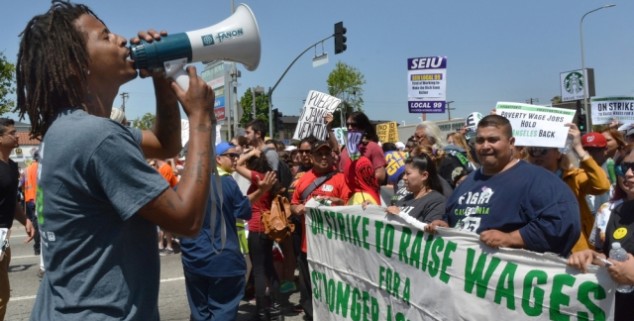Opinion
Don’t forget the median wage — and higher
 A man addresses a raise-the-minimum-wage demonstration in Los Angeles. (Photo: Dan Holm)
A man addresses a raise-the-minimum-wage demonstration in Los Angeles. (Photo: Dan Holm)While lawmakers were cutting themselves up over the thorny minimum wage bill this week, a powerful conversation took place three blocks away from the capitol. Industry, union and college leaders were working through the pragmatic next steps on a modest proposal to move more Californians from minimum wage to medium wages and higher.
The agenda was real jobs available now, jobs of the future and with a future. Jobs in health care, energy management, bio-technology and advanced manufacturing. The proposal is a new workforce development program that links colleges and employers to efficiently prepare unskilled Californians for those existing jobs. The long-term play is to create a talent pool deep enough to attract additional business investment to California.
There is a healthy debate among insiders about how to allocate the funds – but at least the governor’s proposal started the conversation in the right place.”
Given the increasing and bipartisan concern about persistent, pernicious and inter-generational poverty, a “workforce first” strategy should be a top priority that everyone can get behind. After all, the answer to income inequality is income growth – where jobs grow into careers with enterprises providing highly valued goods and services.
Even where there are disagreements, workforce development can be the policy that brings adversarial interests together – and solve more than poverty. For example, California is not going to change the globe by regulating carbon reductions – that will only change California. But the state can drive global climate change solutions if Californians develop and manufacture the technologies that make low carbon economies sustainable and prosperous – beginning with California. Apprenticeship programs already exist in the energy management field, but are not scaled to match the demand.
The CA Economic Summit in 2015 doubled down on its commitment to support workforce development policies capable of filling the estimated need for 1 million more skilled workers. The Summit is comprised of California stewards from the public, private and civic sectors, who are committed to creating a California that is equitable, prosperous and sustainable.
The Community College Chancellor’s office has been an active partner in the Summit, and Summit leaders participated in 2015 on the Chancellor’s Task Force on Workforce, Job Creation and a Strong Economy. Governor Brown embraced those recommendations and is proposing the Strong Workforce Program that is outlined in budget “trailer bill” language.
Perhaps not surprising, the trailer bill is getting none of the attention of the minimum wage war.
The bill would add $200 million for Career Technical Education to the nearly $8 billion budget for the state’s 113 community colleges.
There is a healthy debate among insiders about how to allocate the funds – but at least the Governor’s proposal started the conversation in the right place: The additional money should go to programs determined by college and business leaders working regionally to align programs, students, and jobs on a career path.
The debate is foundational because effective regional collaborations – already endorsed by the Economic Summit’s regional partners – would create a mechanism that could continuously steer higher education spending toward social and economic priorities.
Some of the larger employers are already “self-provisioning,” running their own training programs, and have demonstrated a willingness to more strategically partner with colleges to improve the quality and quantity of programs. Entire industry sectors have developed certification standards that allow workers to go from entry-level to mid- and even upper-level positions – if public education and training dollars can help fill the pipelines with students.
But even those programs are not meeting the demand for jobs, forcing students to pay north of $10,000 to private training providers for skills they should be learning through community colleges.
The Assembly Appropriations Committee has estimated that raising the minimum wage would cost government — as an employer – some $3.6 billion a year.
If California ramped up CTE spending – in partnership with employers and disciplined to succeed – so that one million more Californians made $45,000-a-year to start, how much more would families earn and pay in taxes, and how much less would government pay for safety net programs that cannot be sustained for the 24 percent of the people now in poverty?
One million. That is the estimate – probably low – of the gap over the next decade between middle skilled jobs and the number of skilled workers. As large as that sounds, it is entirely solvable.
To be sure, the minimum wage debate is as important as it is difficult. For goodness sake, I earned nearly $10 per hour as a (unionized) grocery clerk in the late 1970’s. It also is fraught with peril, especially given the significant differences in California’s regional economies and the complicated tradeoffs between government-mandated wages and business and job growth. Moreover, even if lawmakers get the policy as right as possible, it is only a partial solution to one of our biggest challenges.
When we have completed the necessary debate over minimum wage, can we negotiate with equal passion the details of a workforce development investment strategy that will turn the minimum wage into a temporary wage for 1 million Californians?
—
Ed’s Note: Corrects 13th-14th grafs by attributing figures to Assembly Appropriations Committee, instead of Mac Taylor. Jim Mayer is President and CEO of California Forward, a nonprofit government reform group.
Want to see more stories like this? Sign up for The Roundup, the free daily newsletter about California politics from the editors of Capitol Weekly. Stay up to date on the news you need to know.
Sign up below, then look for a confirmation email in your inbox.

Leave a Reply